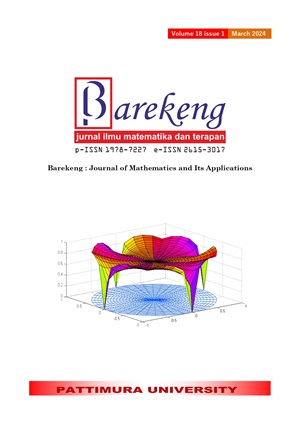ANALYSIS OF THE COOPERATIVE LOTKA-VOLTERRA MODEL IN THE CASE OF TWO AUTOMOTIVE INDUSTRIES IN INDONESIA
Abstract
The automotive industry sector is one of the main sectors contributing to the national economy. Companies in the automotive industry work together to increase productivity and win the market competition. This research aims to construct the cooperative interaction between two companies into the cooperative Lotka-Volterra model. The cooperative Lotka-Volterra model was analyzed for stability at the equilibrium point and bifurcation analysis was performed. Sales data for the Calya 1.2 G product from PT Toyota Motor Manufacturing Indonesia and sales data for the New Sigra 1.2 R MT product from PT Astra Daihatsu Motor are applied to the model. The results of the study show that there is a model that explains the cooperative interaction of the two companies, namely the cooperative Lotka-Volterra model. Four equilibrium points are obtained with three equilibrium points being unstable and the fourth equilibrium point being stable with conditions. The Hopf bifurcation analysis of the model shows that there are no parameters that cause a change in stability from initially stable to unstable. The data simulation shows that the cooperation of the two companies is mutually beneficial because it increases the number of sales and creates balanced market conditions.
Downloads
References
Menperin, “Menperin: Industri otomotif jadi sektor andalan ekonomi nasional,” 2022.
R. May, “Models for Two Interacting Populations,” Theoretical Ecology: Principles and Applications , vol. 2, pp. 78–104, 1925.
A. J. Lotka, Elements of Physical Biology . Baltimore: Williams and Wilkins, 1925.
V. Volterra, “Fluctuations in the abundance of a species considered mathematically,” Nature, vol. 118, pp. 271–282, 2003.
H. Cho, A. L. Lewis, K. M. Storey, and H. M. Byrne, “Designing experimental conditions to use the Lotka–Volterra model to infer tumor cell line interaction types,” J Theor Biol, vol. 559, Feb. 2023, doi: 10.1016/j.jtbi.2022.111377.
X. Guo, L. Wu, and M. Wang, “Application of Grey Lotka-Volterra Model in Water-Economy-Industry-Technology Innovation System in Beijing-Tianjin-Hebei Region,” Int J Environ Res Public Health, vol. 19, no. 15, Aug. 2022, doi: 10.3390/ijerph19158969.
Z. Jiang, A. Halik, and A. Muhammadhaji, “Dynamics in an n-Species Lotka–Volterra Cooperative System with Delays,” Axioms, vol. 12, no. 5, May 2023, doi: 10.3390/axioms12050501.
N. Mohan, “Coexistence states of a Lotka Volterra cooperative system with cross diffusion,” Partial Differential Equations in Applied Mathematics, vol. 4, Dec. 2021, doi: 10.1016/j.padiff.2021.100072.
Z. Zhang, “Mutualism or cooperation among competitors promotes coexistence and competitive ability,” Ecol Modell, vol. 164, no. 2–3, pp. 271–282, Jun. 2003, doi: 10.1016/S0304-3800(03)00069-3.
L. Listiyana and K. P. Krisnawan, “Analisis Bifurkasi Pada Model Matematis Predator Prey Dengan Dua Predator,” Jurnal Kajian dan Terapan Matematika , vol. 5, no. 6, pp. 1–12, 2016.
J. Hale and H. Kocak, Dynamic and Bifurcation. New York: Springer-Verlag, 1991.
Gaikindo, “Indonesian Automobile Industry Data 2021.” [Online]. Available: https://www.gaikindo.or.id/indonesian-automobile-industry-data/
Gaikindo, “Indonesian automobile industry data 2022.” Accessed: Dec. 01, 2022. [Online]. Available: https://www.gaikindo.or.id/indonesian-automobile-industry-data/
J. D. Murray, Mathematical Biology : An Introduction, 3rd ed. New York: Springer, 2002.
P. F. Verhulst, “Mathematical Researches Into The Law Of Population Growth Increase,” Nouveaux M emoires de l’Acad emie Royale des Sciences et Belles-Lettres de Bruxelles , vol. 18, pp. 1–42, 1845.
A. Salisbury, “MATHEMATICAL MODELS IN POPULATION DYNAMICS,” 2011.
S. Y. Wang, W. M. Chen, and X. L. Wu, “Competition Analysis on Industry Populations Based on a Three-Dimensional Lotka-Volterra Model,” Discrete Dyn Nat Soc, vol. 2021, 2021, doi: 10.1155/2021/9935127.
R. E. Williamson, Introduction to Differential Equations and Dynamical Systems . New York: McGraw-Hill Science, 1997.
R. Haberman, Mathematical Models : Mechanical Vibration, Population Dynamics, and Traffic law. Philadelphia: SIAM (Society for Industrial and Applied Mathematics, 1998.
D. Savitri, “Penentuan Bifurkasi Hopf Pada Predator Prey,” 2005.
V. Sundari, “Bifurkasi Hopf Pada Model Mangsa-Pemangsa Tipe Leslie Dengan Fungsi Respons Holing Tipe III,” Institut Pertanian Bogor, Bogor, 2016.
A. W. Wijeratne, F. Yi, and J. Wei, “Bifurcation analysis in the diffusive Lotka-Volterra system: An application to market economy,” Chaos Solitons Fractals, vol. 40, no. 2, pp. 902–911, Apr. 2009, doi: 10.1016/j.chaos.2007.08.043.
Copyright (c) 2024 Zahra Febrilia Rachmawati, Sutrima Sutrima, Ririn Setiyowati, Vika Yugi Kurniawan

This work is licensed under a Creative Commons Attribution-ShareAlike 4.0 International License.
Authors who publish with this Journal agree to the following terms:
- Author retain copyright and grant the journal right of first publication with the work simultaneously licensed under a creative commons attribution license that allow others to share the work within an acknowledgement of the work’s authorship and initial publication of this journal.
- Authors are able to enter into separate, additional contractual arrangement for the non-exclusive distribution of the journal’s published version of the work (e.g. acknowledgement of its initial publication in this journal).
- Authors are permitted and encouraged to post their work online (e.g. in institutional repositories or on their websites) prior to and during the submission process, as it can lead to productive exchanges, as well as earlier and greater citation of published works.






1.gif)



